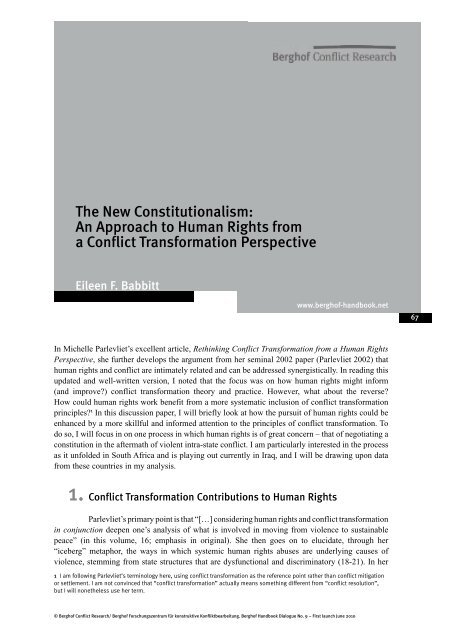Human rights and conflict transformation: The challenges of just peace
Human rights and conflict transformation: The challenges of just peace
Human rights and conflict transformation: The challenges of just peace
Create successful ePaper yourself
Turn your PDF publications into a flip-book with our unique Google optimized e-Paper software.
<strong>The</strong> New Constitutionalism:<br />
An Approach to <strong>Human</strong> Rights from<br />
a Conflict Transformation Perspective<br />
Eileen F. Babbitt<br />
www.bergh<strong>of</strong>-h<strong>and</strong>book.net<br />
In Michelle Parlevliet’s excellent article, Rethinking Conflict Transformation from a <strong>Human</strong> Rights<br />
Perspective, she further develops the argument from her seminal 2002 paper (Parlevliet 2002) that<br />
human <strong>rights</strong> <strong>and</strong> <strong>conflict</strong> are intimately related <strong>and</strong> can be addressed synergistically. In reading this<br />
updated <strong>and</strong> well-written version, I noted that the focus was on how human <strong>rights</strong> might inform<br />
(<strong>and</strong> improve?) <strong>conflict</strong> <strong>transformation</strong> theory <strong>and</strong> practice. However, what about the reverse?<br />
How could human <strong>rights</strong> work benefit from a more systematic inclusion <strong>of</strong> <strong>conflict</strong> <strong>transformation</strong><br />
principles? 1 In this discussion paper, I will briefly look at how the pursuit <strong>of</strong> human <strong>rights</strong> could be<br />
enhanced by a more skillful <strong>and</strong> informed attention to the principles <strong>of</strong> <strong>conflict</strong> <strong>transformation</strong>. To<br />
do so, I will focus in on one process in which human <strong>rights</strong> is <strong>of</strong> great concern – that <strong>of</strong> negotiating a<br />
constitution in the aftermath <strong>of</strong> violent intra-state <strong>conflict</strong>. I am particularly interested in the process<br />
as it unfolded in South Africa <strong>and</strong> is playing out currently in Iraq, <strong>and</strong> I will be drawing upon data<br />
from these countries in my analysis.<br />
1. Conflict Transformation Contributions to <strong>Human</strong> Rights<br />
Parlevliet’s primary point is that “[…] considering human <strong>rights</strong> <strong>and</strong> <strong>conflict</strong> <strong>transformation</strong><br />
in conjunction deepen one’s analysis <strong>of</strong> what is involved in moving from violence to sustainable<br />
<strong>peace</strong>” (in this volume, 16; emphasis in original). She then goes on to elucidate, through her<br />
“iceberg” metaphor, the ways in which systemic human <strong>rights</strong> abuses are underlying causes <strong>of</strong><br />
violence, stemming from state structures that are dysfunctional <strong>and</strong> discriminatory (18-21). In her<br />
1 I am following Parlevliet’s terminology here, using <strong>conflict</strong> <strong>transformation</strong> as the reference point rather than <strong>conflict</strong> mitigation<br />
or settlement. I am not convinced that “<strong>conflict</strong> <strong>transformation</strong>” actually means something different from “<strong>conflict</strong> resolution”,<br />
but I will nonetheless use her term.<br />
© Bergh<strong>of</strong> Conflict Research/ Bergh<strong>of</strong> Forschungszentrum für konstruktive Konfliktbearbeitung. Bergh<strong>of</strong> H<strong>and</strong>book Dialogue No. 9 – First launch June 2010<br />
67

















